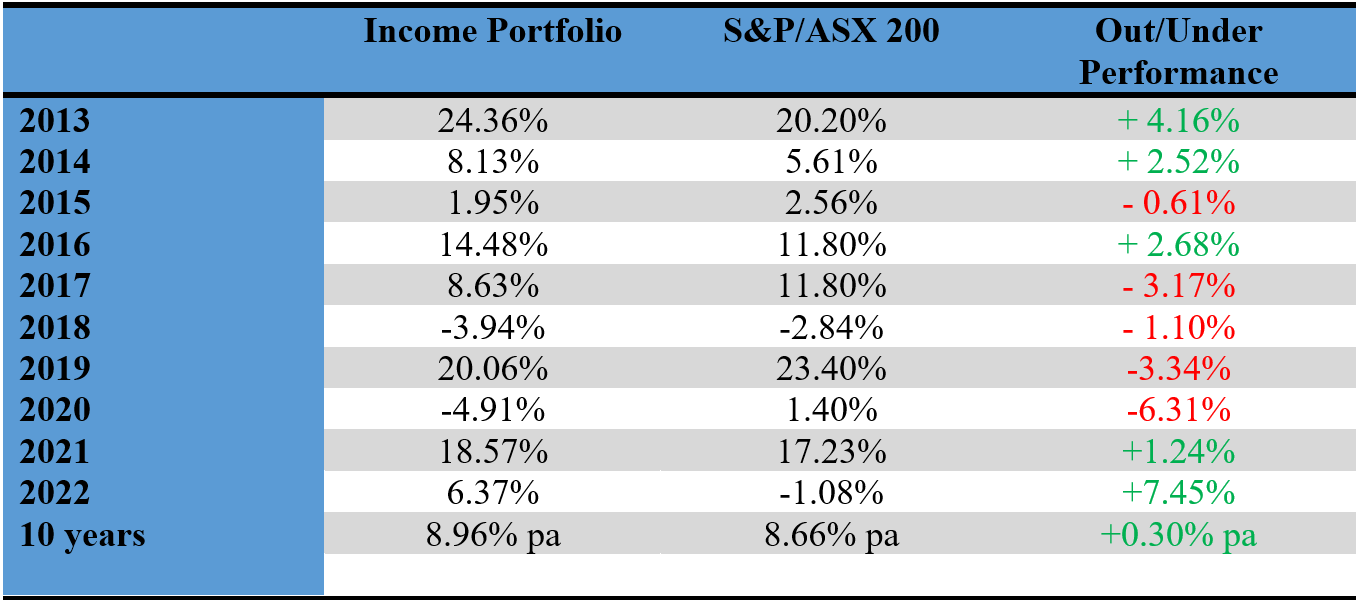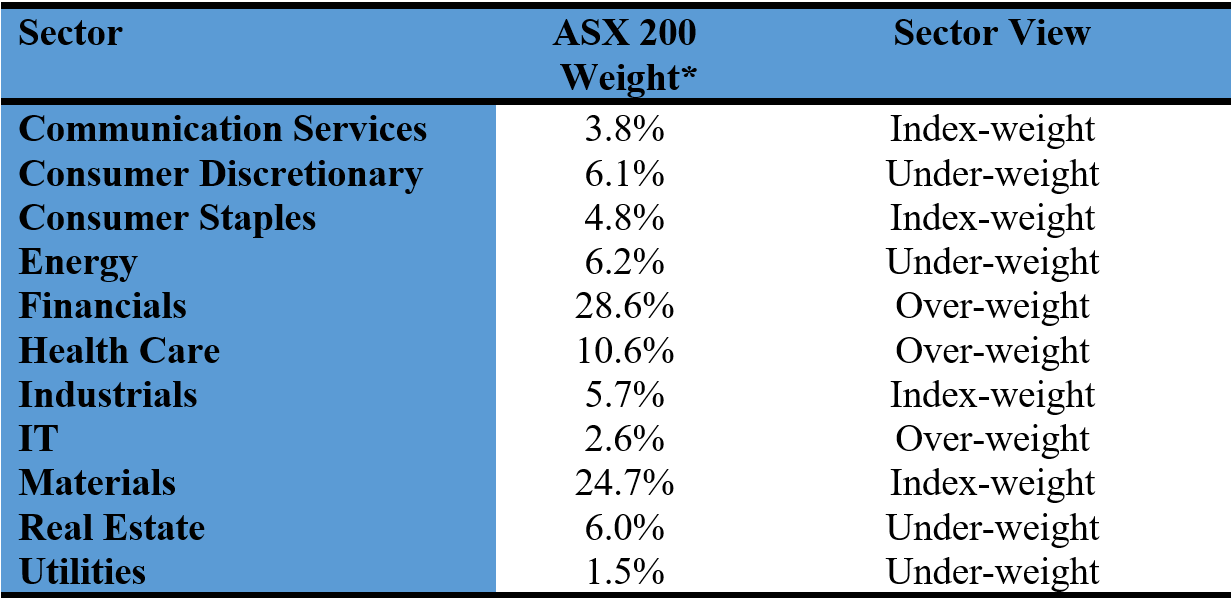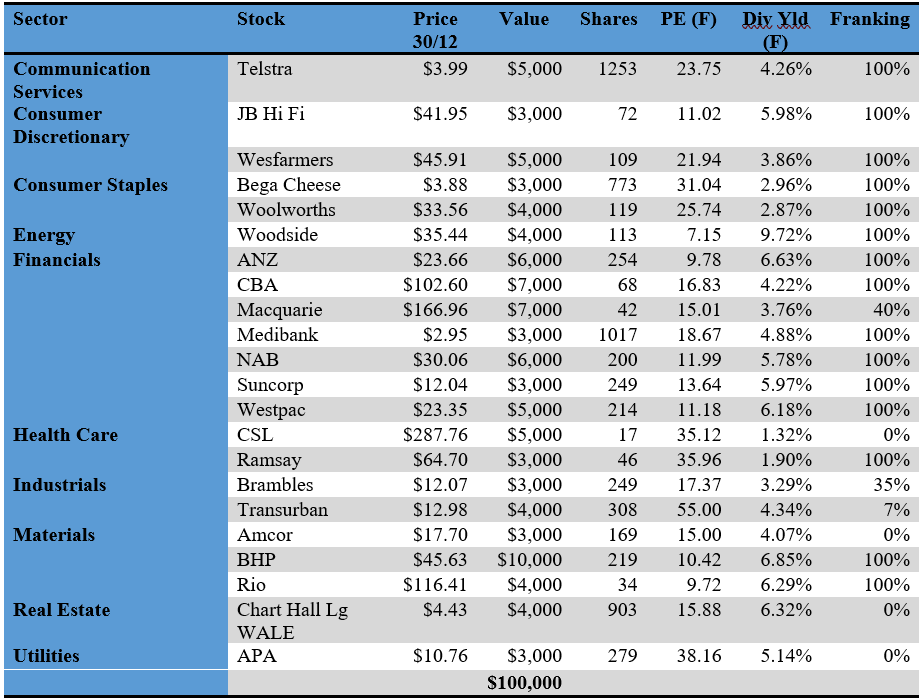The purpose of our model portfolios (income and growth) is to demonstrate an approach to portfolio construction that SMSFs or personal investors could apply.
We have made some minor changes to our portfolios for 2023 to take into account the dominant investment themes that we expect to apply. We have also rebalanced the portfolios.
Recap on portfolio objectives and performance
The objective of the income portfolio is to deliver tax advantaged income whilst broadly tracking the S&P/ASX 200.
Typically, it has delivered an income return of around 4.5% to 5.0% pa, franked to around 80%, with the balance of the return comprising capital gain or loss.
The table below shows the total performance of the income portfolio and that of the benchmark S&P/ASX 200. Over the ten years since 2013, it has delivered an annualized average return of 8.96% pa compared to the index return of 8.660%. These figures don’t include the benefits of franking credits or from participating in capital actions such as off-market share buybacks or share purchase plans.

The objective of the growth portfolio is to outperform the S&P/ASX 200 market over the medium term, whilst closely tracking the index.
The table below shows the performance of the growth portfolio and that of the benchmark S&P/ASX 200. Over the nine years since 2013, it has delivered an annualized average return of 9.52% pa, outperforming the index by 0.86% pa. These figures don’t include the benefits of franking credits or from participating in capital actions such as off-market share buybacks or share purchase plans.

Portfolio Construction Rules
The construction rules for the portfolios are:
- we use a ‘top down approach’ looking at the prospects for each of the industry sectors;
- for the income portfolio, we introduce biases that favour lower PE, higher yielding sectors;
- so that we are not overly exposed to a market move, in the major sectors (financials and materials), our sector biases will not be more than 33% away from index. For example, the weighting of the ‘materials’ sector on the S&P/ASX 200 is currently 24.7%, and under this rule, our possible portfolio weighting is in the range from 16.5% to 32.9% (i.e. plus or minus one third or 8.2%);
- we require 20 to 30 stocks (less than 10 is insufficient diversification, over 30 it is too hard to monitor), and have set a minimum stock investment size of $2,500;
- our stock universe is confined to the ASX 150. This has important implications for the growth portfolio because the stocks with the best medium term growth prospects will often come from outside this group (the so called ‘small’ caps);
- for the income portfolio, we prioritise stocks that pay fully franked dividends and have a consistent record of paying dividends; and
- within a sector, the stocks are broadly weighted to their respective index weights, although there are some biases.
Investment themes and sector outlook for 2023
In summary, we expect the following major investment themes:
- Equity markets will have a better year in 2023, buoyed by the view that interest rates will peak and will be on the way down by 2024. However, we expect it to be fairly choppy;
- Headline inflation will continue to moderate;
- The US economy will avoid a recession (or if there is one, it will be mild and shallow). Australia will fare better than the USA and record moderate economic growth, in part due to a better starting point (lower currency and smaller deficit), and the impact of a recovering China; and
- The US dollar will continue to weaken and the Australian dollar will head higher. Most commodities (with the possible exception of oil) will remain well supported. The strengthening Australian dollar will place some pressure on Australian stocks with material overseas earnings.
And the main risks?
- China (covid, growth, political unrest);
- The war in Ukraine escalating;
- And of course, a “black swan”
From these themes and other data, we have determined our sector views, which are expressed as a bias relative to the sector’s market weighting.

ASX 200 index weights as of 31 December 2022
Overall, our sector views are not strong and so the biases will be relatively small.
Income Portfolio
The objective of the income portfolio is to deliver tax advantaged income whilst broadly tracking the S&P/ASX 200.
On a sector basis, the biases for the income portfolio in 2022 are fairly minor. It is overweight financials (in order to find income) and consumer facing sectors, and underweight health care and information technology (where there are very few medium yielding stocks).
In the expectation that interest rates will rise moderately in Australia in 2023, it has a defensive orientation and a bias to yield style stocks. In a bull market, we expect that the income portfolio will underperform relative to the broader market due to the underweight position in growth oriented sectors and the stock selections being more defensive, and conversely in a bear market, it should moderately outperform.
Apart from re-balancing and moderate changes with some stock weights, changes to the portfolio from 2022 are the inclusion of Ramsay Health Care and the removal of Sonic Health Care.
Using consensus analyst forecasts from FN Arena, the income portfolio has the following characteristics:
Forecast Price Earnings (PE) for 20232: 19.2 times Forecast PE for 2022 (excluding Transurban, APA and CLW):
17.0 times Forecast Dividend Yield for 2023: 5.0%
Franking:80.3% (estimated)
Forecast Dividend Yield (excluding WDS, BHP and Rio): 4.45%
The forecast dividend yield of 5.0% is based on stock prices as of 31 December 2022. The franking percentage of 80.3% is reduced by the inclusion of stocks such as Transurban, APA, Charter Hall Long WALE REIT, Amcor, CSL and to a lesser extent, Macquarie and Brambles.
For an SMSF in the accumulation phase, the forecast 5.0% dividend yield translates to an income return of 5.8% (after tax), and for a fund in pension phase, to 6.7%.
High forecast dividends from Woodside, BHP and RIO will boost the dividend yield in 2023, but over the medium term, are expected to be lower. When these stocks are excluded, the portfolio yield drops from 5.0% to 4.45%.
Our income portfolio per $100,000 invested (using prices at the close of business on 30 December 2022) is:

Growth Portfolio
The objective of the growth portfolio is to outperform the S&P/ASX 200 market over the medium term, whilst closely tracking the index.
The growth portfolio in 2022 is moderately overweight financials, health care and information technology. It is moderately underweight industrials, real estate and utilities. Overall, the sector biases are not strong.
Apart from re-balancing and moderate changes with some stock weights, changes from the final 2022 portfolio are the inclusion of Ramsay Health Care and the exclusion of Sonic Health Care.
Using consensus broker forecasts from FN Arena, the portfolio has the following characteristics:
Forecast Price Earnings (PE) multiple for 2023: 35.3 times
Forecast PE for 2022 (excluding Qantas, NextDC, Xero & BlueScope): 17.3 times
Forecast Dividend Yield for 2023: 4.25%
Franking: 82.1% (estimated)
Forecast Dividend Yield (excluding WDS, BHP and Rio): 3.71%
High forecast dividends from Woodside, BHP and RIO will boost the dividend yield in 2023, but over the medium term, are expected to be lower. When these stocks are excluded, the portfolio yield drops from 4.25% to 3.71%.
Our growth portfolio per $100,000 invested (using prices as at the close of business on 30 December 2022) is as follows:

Important: This content has been prepared without taking account of the objectives, financial situation or needs of any particular individual. It does not constitute formal advice. Consider the appropriateness of the information in regards to your circumstances.

